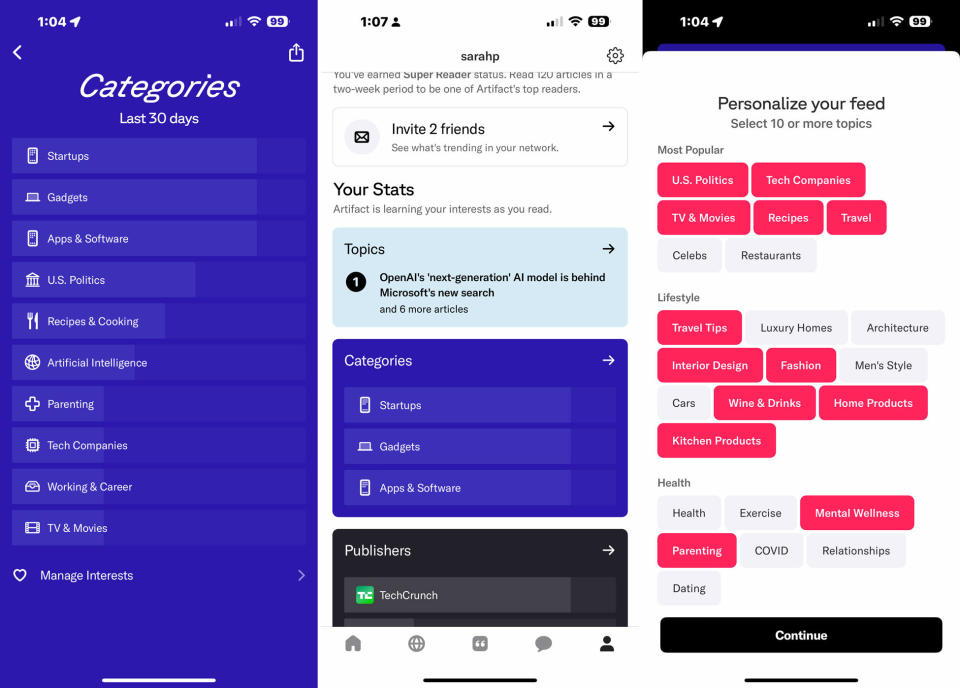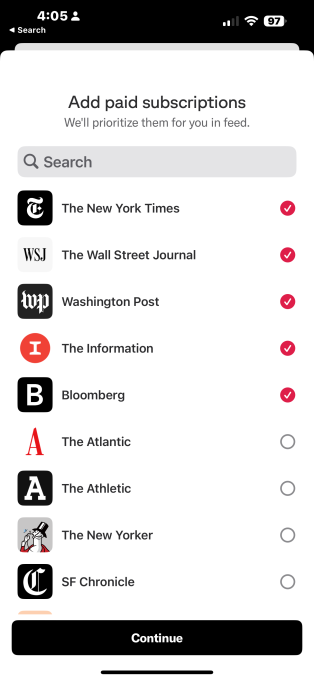The tech behind Artifact, the newly launched news aggregator from Instagram's co-founders
Late last month, Artifact, a personalized news reader built by Instagram’s co-founders, opened to the public. The launch was a surprise to many consumers, who wondered why the team behind one of the world's most iconic social apps would return to startups to focus on one of the toughest areas instead: news. It's an ecosystem where publishers are failing left and right and misinformation is rampant, as the founders surely saw themselves while working at Facebook.
In an interview, Instagram co-founder Kevin Systrom explains what drew him to this space and how his new app's underlying technology will serve to differentiate it from the competition.
The startup's existence, in some ways, can be credited to the COVID pandemic, as that's what brought the Instagram co-founders, Systrom and Mike Krieger, back together. During the early days of the pandemic in 2020, the co-founders teamed up for the first time since leaving Facebook to create a COVID-19 dashboard called Rt.live that tracked the spread of the virus across the U.S.
But in later months, other COVID trackers emerged and people were no longer as interested in tracking the virus's spread on a state-by-state basis. Invigorated by the experience, the founders began then to think about returning to work on a "real company" instead of a public good side project.
Machine learning is the "future of social"

Image Credits: Usis / Getty Images
Deciding on their next act took time. The founders hacked around on stuff for a year and a half or so after their initial collaboration, Systrom says. The founder, who describes himself as a "very frameworks-driven person," knew he wanted to do something that involved machine learning, having seen its power at Instagram.
"It was super fascinating to me to work on it at Instagram and watch it go from a company without machine learning to a company driven by machine learning," he says. "I also witnessed the rise of TikTok and realized how important machine learning would be for the future of social."
He himself observed how social networking's underlying graph had changed a lot over the years, watching as Facebook invented what's now known as the "friend graph" -- a user's personal social network of real-life connections. Later, he saw Twitter pioneer the "follow graph," or a graph of connections based on the user's explicit choices of who they want to follow on a service. Then, at Instagram, Systrom saw firsthand the shift from the "follow graph" to the "inferred graph" or, rather, the "interest graph."
This, he explains, was basically a "follow graph" powered by machine learning, instead of by users clicking a button.
The potential to leverage machine learning and an interest graph within a new product appealed to him, he says.
"We looked for an area that was social in nature, but where we could apply 20% new techniques -- and that would be the machine learning side of what we're doing," Systrom says, describing how the founders narrowed their focus.
Fixing a broken news ecosystem

Image Credits: jayk7 (opens in a new window) / Getty Images
The other consideration that prompted the founders' interest in news, more specifically, was the potential impact if the app succeeded. They wanted to work on a startup they felt the world needed, Systrom says. No doubt, some of that interest may have been fueled by working at Facebook (now Meta), which had changed consumers' news consumption behavior, impacting publishers as well as the spread of misinformation.
"It felt like our consumption of information -- both factual, balanced, entertaining, etc. -- had an existential crisis," Systrom tells TechCrunch. Plus, he adds, "many of the people producing this content are going out of business."
Meanwhile, on the consumer side of the news reading experience, there's so much information swirling around that people don't know what they can trust or which item to read. People are asking themselves if a link shared by a friend is actually legit and they're wondering why they're reading one article over the many others published on the same topic.
"It might be cheesy to say, because I've now said it a bunch of times, but I feel like the worst part about social media is that it's social," Systrom says. "I think the 'social' part of social media -- for a long time, in terms of information consumption -- has been a hack to filter for information that would be interesting to you. But we now don't need that hack, because we can learn what's interesting to you," he continues. "We can quantify it. We can build profiles. And then we can serve you content that is both high-quality, balanced and interesting to you."
This realization led to the creation of Artifact, a social news app powered by machine learning.

Image Credits: Artifact personalization and stats
The app in some ways is very much like others that exist today, which have been founded in other countries, including ByteDance's Toutiao in China, Japan's SmartNews and News Break, another personalized news reader with Chinese roots. Like its rivals, Artifact learns from user behavior, engagement and other factors in order to personalize which headlines are presented and in which order.
Despite this competitive landscape, Systrom believes U.S. news consumers want an option that's actually based in their home market.
"They want a domestic player with a team they trust," Systrom says, speaking to the news aggregation landscape in the U.S.
His comment is a timely one, given how tensions in the U.S. have been growing over China's grip on the social networking market with TikTok. The short video app, which is often used as a source for news by Gen Z, is now banned on government phones and bipartisan legislation to further police it is in the works.
Clearing out the clickbait
In addition to its locale, Systrom believes Artifact will be able to differentiate itself based on its unique combination of technology and taste -- a directive that could also be used to describe Instagram's founding for that matter.
Unlike Facebook -- which became a platform by which any publisher could deliver news, and oftentimes clickbait -- Artifact's news sources are curated up front, the founder explains.
"When I say taste, I mean the top of the funnel in our system -- the publishers we choose to distribute," notes Systrom. "It's not a free-for-all. We don't crawl the entire web and just let everything go in."
Instead, Artifact has selected the top publishers across different categories to fuel the content in the app. Customers can add their own paid subscriptions, as well. At this time, Artifact doesn't sell those for a revenue share or involve itself in publishers' ad sales, though one day that could change, depending on how the app chooses to monetize.
For now, however, the focus is on gaining traction with consumers and ensuring the app's news sources are worth reading.


 Yahoo Autos
Yahoo Autos 